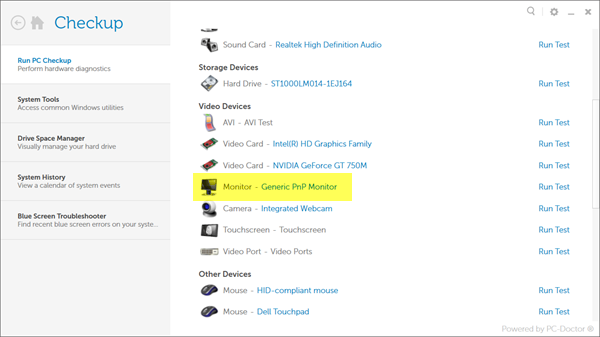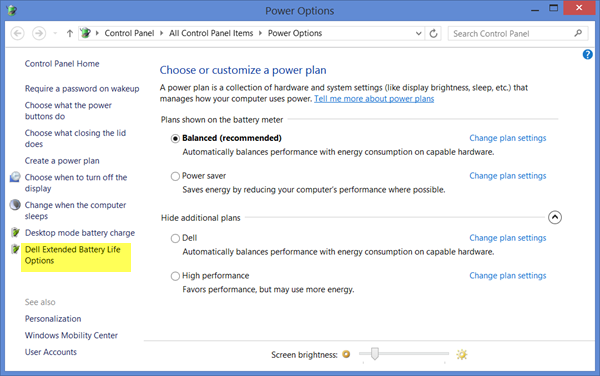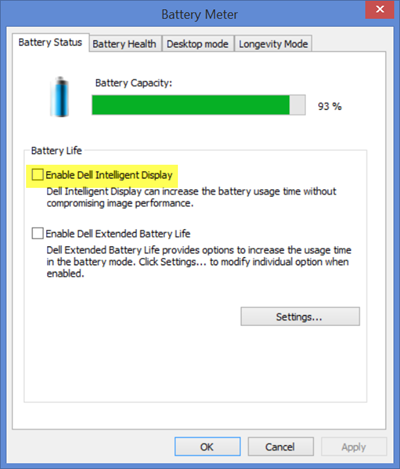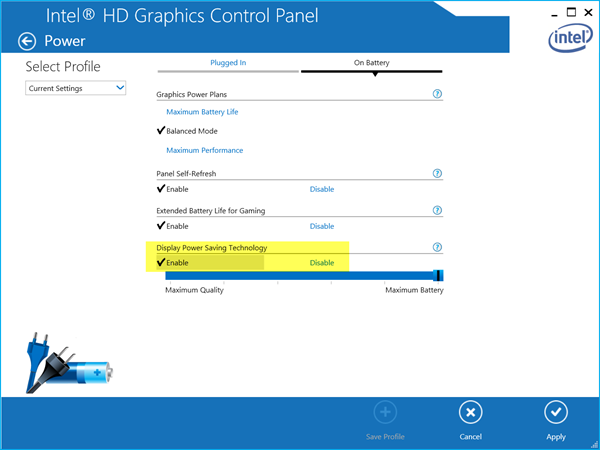If your Windows 11/10 desktop or laptop screen brightness is flickering, blinking, or flashing randomly or when on battery power, this post suggests methods to resolve this problem. I recently bought a new computer and was facing this issue. This post will work for Dell, HP, Lenovo, Acer, and other computers.
Windows computer screen flickering
If your computer screen flickers, pulsates, dims, or brightens occasionally, you may see if any of these troubleshooting suggestions help you. Some of them may apply to a Desktop, and others to a laptop.
First, try to identify when you face this issue, whether it is on battery power, the main AC adapter, or both scenarios. Is it for a particular power plan or all power plans? Also, check if this happens when you enter BIOS and in Safe Mode. Is your battery very old? Having this bit of information may help you.
You may try these steps in any order. Select the ones that you think apply to your scenario and are more likely to help you.
- Update Graphics Driver
- Uninstall and reinstall the Display driver
- Restore default Power plan
- Change the Monitor Refresh Rate
- Disable Dell Intelligent Display
- Disable Intel Power Saving Technology
- Check third-party software issues
- Run Hardware Troubleshooter
- Troubleshoot in Clean Boot State
- Check if it is a hardware issue
- Tweak some Display settings.
How to fix a blinking screen on Windows laptop
1] Update Graphics Driver
Press Ctrl+Win+Shift+B to restart the graphics driver and see if it helps. If not, then all visit the manufacturer’s website and update your video and graphic drivers, for your model.
2] Uninstall and reinstall the Display driver
If updating does not help, uninstall, and reinstall the Video drivers.
- Boot Windows in safe mode.
- Right-click the Start button and select Device Manager.
- Expand the Display adapters section
- Right-click the listed adapter
- Select Uninstall device
- Select the Delete the driver software for this device checkbox
- Then again select Uninstall
- Restart your PC.
After your PC restarts, Run Windows Update and install the available driver update that may be offered.
Read: Computer screen looks washed out or Fading monitor screen.
3] Restore default Power plan
Open Control Panel\All Control Panel Items\Power Options\Edit Plan Settings and restore the default power plan settings by clicking on Restore default settings for this plan. Do this for all your Power Plans.
Fix: Screen flickering issues while playing games on PC
4] Change the Monitor Refresh Rate
Change the Monitor Refresh Rate and see if that helps.
5] Disable Dell Intelligent Display
Open My Dell and Run PC Checkup for your Monitor. If any issues are detected, follow its instructions to address the issue.

Open Power Options in Control Panel, and from the left side, select Dell Extended Battery Life Options.

The Battery Meter settings box will open. Uncheck Enable Dell Intelligent Display. Click Apply and Exit.

See if this helps.
Related: Bottom half of my screen is flickering in Windows
6] Disable Intel Power Saving Technology
If your laptop uses Intel processors, disable the Intel Power Saving Technology. You will get this setting in your Dell or Vaio Control Center. From the Start Screen search, type Intel HD Graphics Control Panel and hit Enter to open it. Click on Power > On Battery.

You will see Display Power Saving Technology. Disable it, click Apply and restart your computer.
7] Check third-party software issues
Norton AV, iCloud, and IDT Audio are three apps that are known to cause screen flickering in Windows. Check if you have them installed. See this post if your computer screen is flickering after upgrading Norton.
8] Run Hardware Troubleshooter
Run the Hardware Troubleshooter and see if it helps you.
9] Troubleshoot in Clean Boot State
Open the Task Manager. If the Task Manager flickers along with everything else on the screen, your display driver could be the culprit. You thus need to update or rollback the driver.
If Task Manager doesn’t flicker while the rest of the screen is flickering, an incompatible app could be causing the problem.
Troubleshoot in Clean Boot State to identify the offender and uninstall the program.
10] Check if it is a hardware issue
If the whole screen flickers, it is likely a driver issue, but if only a corner or a part flickers, it could be a hardware issue. You may need to take it to a hardware engineer and get it checked.
11] Tweak some Display settings
You may try the following workaround that has helped some resolve their Windows 11 screen flickering issue:
- Open Windows 11 Settings
- Open Personalization settings
- Select Background
- Set the background Solid color or Picture. Do not use Slideshow
- Next, click on Colors and set Accent Color to Manual.
- You may also disable Animation Effects from Accessibility settings and see if that helps.
How to fix screen flickering while watching YouTube?
If you PC screen is flickering while watching YouTube, update your browser, the YouTube app and your Display drivers. To fix a general YouTube glitch screen, try hard-refreshing the page by pressing Shift+F5 key. This often resolves graphical issues caused by improper loading.
Read: Monitor blinking when USB connected to PC
How to fix screen flickering on system startup?
Monitor flickering when first turned on can be due to hardware issues, outdated drivers, or software glitches. Check for loose cables, update your graphics drivers, and scan your system for malware. Adjusting your monitor’s refresh rate and ensuring all connections are secure can also help. To update your graphics, start your PC in Safe Mode, open Device Manager, and update the display drivers under the Display adapters section. This process usually resolves the flickering issue.
Other resources:
- Screen is flickering on Surface Book.
- How to clear the Display cache in Windows
- Windows Brightness not working or changes automatically
- Second monitor flickering on and off
Let us know if any of these helped you fix your laptop screen flickering issue or if you have any other suggestions.
Screen flickering at low brightness in Windows 11
If your screen flickers at low brightness in Windows 11/10, update the drivers for your display adapters and remove any third-party brightness control software you may have installed.
Read:
How do I fix PC screen flashing black and white?
If your PC screen keeps flickering or flashing black and white, it is caused by your Display driver or an interfering 3rd-party program. We suggest you update your Graphics driver and troubleshoot the issue in Clen Boot State to identify and eliminate the issue.
Read: Screen dims when playing games
Why is the bottom of the screen flickering?
The bottom of the computer screen may flicker if you have outdated or incompatible display drivers, faulty screen or hardware components, or due to overheating. To resolve the issue, update your drivers, check the hardware, and ensure proper ventilation.
Read: Screen flickering when adjusting volume on Windows PC.
Brilliant! I came across this problem on my Lenovo laptop after Windows 8.1 August Update. 7th option worked for me. It was really annoying but I fixed it from your help @AnandKhanse Sir!
Thank you :)
Glad it helped. :)
It fixed the brightness flickering problem with my DELL 7537, but it only works when it plugged off. What can I do with it when AC plugged in? There is no display power saving option on plugged in tab.
Thank you so much. The 7th option worked for me I’ve been looking for a solution to this problem for months!
Thanks again!
The only definitive solution to this problem (rather than disabling various options) is to go windows service and disable the sensor service.
Do the following:
1. Press “Windows Key + R” to open the command menu.
2. Type “services.msc” and press enter
3. Scroll through the list of services and look for “sensor monitoring service”
4. Permanently “Disable” the service.
The “sensor monitoring service” may be used for multiple sensors, but most Dell Laptops have a ambient light sensor that dynamically changes the screen contrast and brightness. This is the only sure way to disable it.
Thank you for your inputs. Yes that option is always there. But most would prefer to try and fix the specific issue first. Why cut the tree just because a branch goes bad. If anyone needs to disable Adaptive Brightness, they can get more details here: https://www.thewindowsclub.com/enable-use-adaptive-brightness-windows-7
Same problem here except it is enabled plugged in or not, same laptop.
There used to be an option, but not anymore since they updated the driver.
I have tried all of these, and a few more like disabling UEFI, installing latest driver from .zip through device manager, disabled the service, unplugged, plugged in, disabled all intel power saving, and settings in power options related to it, and none of them work.
The screen will adjust contrast on a white page slowly, and then adjust on a black page with this flickering/banding effect. Totally fed up of it.
One thing that did work albeit at expense of the battery life is changing NVIDIA optimus settings to use the NVIDIA graphics card instead of Intel POS.
After restarting it appears to be fixed, here is another solution I found elsewhere. Credit xGary Surfacenet forums.
1.Obtain Lastest Intel HD Graphics Driver (Make sure to download the
.zip file version NOT the .exe) from Intel Download Center. Selsect
“Graphics”, “Laptop graphics driver” and the chipset (Surface Pro 1 uses
3rd gen HD4000 & Surface Pro 2 uses 4th gen HD4400)
2.Select your Operating System and download the driver (Windows 8.1 x64)
3.Right click the downloaded .zip and select “Extract to …” and dump it on your desktop or wherever
4.Right click the bottom left corner on your desktop and select “Device Manager”
5.Open “Display adapters”, right click the graphics card and hit “Update Driver Software…”
6.Select the “Browser my computer for driver software”
7.Select “Let me pick from a list of device drivers on my computer”
8.Click “Have Disk…” and browser to the extracted Intel Driver Software on your desktop.
9.In the subfolder “Graphics” open the .inf file
10.Now click “Ok” and continue installing the driver by hitting “Next”…
7th option worked for me
even after doing all this pluss extra reg edits i still get the issue but what I found helps is if you pull the power plug out and put it back in it stops it and goes with what the settings say. fecking silly monitor
Tip no. 7 worked for my Dell 7537. No more flickering, plugged in or not.
I have exactly this same problem with my Dell XPS 15 9550 but it only occurs if the brightness is set to 0. As soon as I increase it to 10% is almost unnoticeable. Anybody else having the same issue with a Dell XPS 15? Any workaround? None of the suggestions worked for me :(
7th option worked for me too. Thank you!
Thanks Helpful (y)
Adding another thank you. Option #7 worked for me too. When I switched to battery, my screen brightness indicator kept flickering on and off. I went to Desktop, right-clicked and selected Screen Resolution. I could see the display flickering between two displays every other second. It was driving me around the bend! Such a simple fix.
For me it was the Intel Graphics Control Panel, just disabling the display power saving technology in Windows 10 worked for me. It was going from a dark background app like Spotify to light white background like Chrome search results, and it would flicker to full brightness going into the white background-this was when my laptop was unplugged/battery not charging. But now, no more flicker. Thank you!
can u please help me
i have got a new laptop (lenovo y50-70) from my dad from the first usage its self the screen start blinking or flickering can u please help me out
Admin, can you please tell that in which version of “Graphics Control Panel” this “Display Power Saving Technology” option comes?
My laptop is Dell Latitude 3340.
Its graphics driver version is 10.18.14.4578.
Awesome! This has solved my problem. It was the Intel Display Power Saver that had been causing my screen to flicker. Thank you very much @happyandyk:disqus ! :D